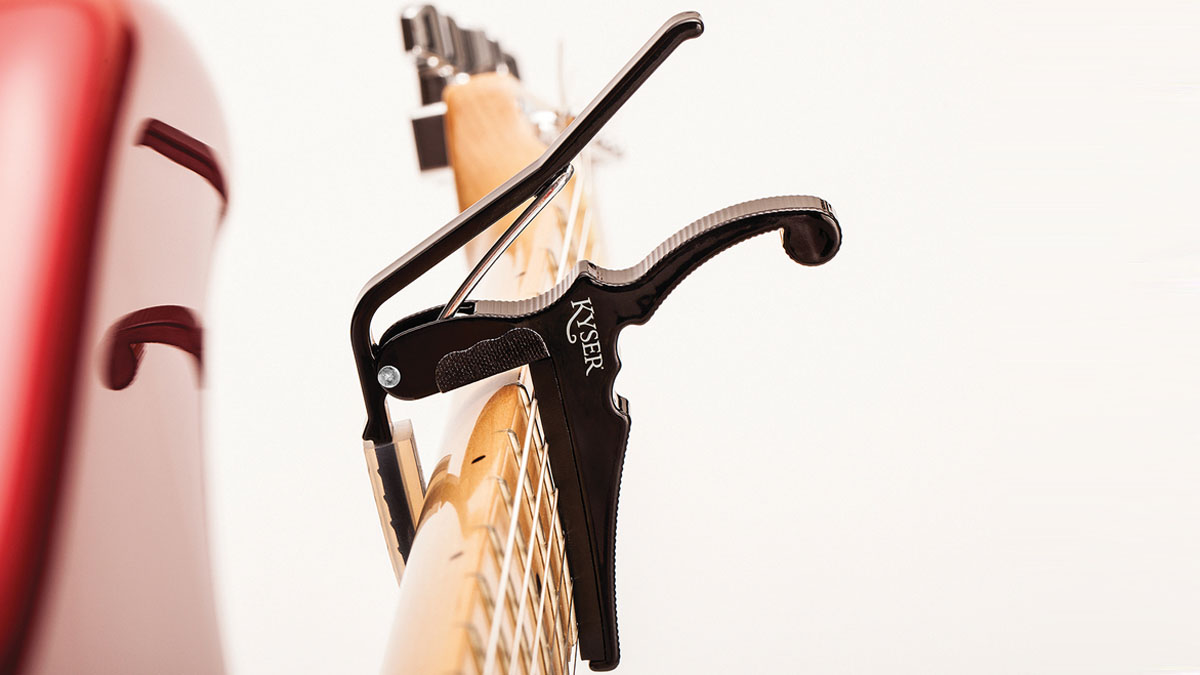How to use a capo on guitar
Here are some tips for better intonation, and how to think of key when using a capo

To minimize the pitch-sharpening effect that can occur when deploying a spring-loaded capo, especially on an electric guitar and/or at higher fretboard positions, firmly press down the “blade” side of your pick hand across the strings over your guitar’s pickups or sound hole as you deploy the capo on the neck with your fret hand.
Doing this “isometric karate chop” while placing the capo will help take up any slack in the strings and even out the tension in front of and behind the capo as it clamps onto and grips the strings, resulting in truer intonation and less “capo weirdness.”
Just as you would do when fretting strings normally with your fingers, when deploying the capo, leave a little space, or gap, between it and the fret you’re placing it behind, positioning it anywhere from a quarter to a half inch away from the fret.
This placement not only creates a less steep angle of the downwardly bent string behind the fret, which helps reduce unwanted pitch sharpening, it also gives the side of your fret-hand index finger a little more “elbow room” to maneuver and properly form 1st-position open chord shapes, such as B7 and D7, without butting into the capo, which can be a big problem, as the capo ends up pushing your hand too far to the right and potentially past the frets that your fingers need to be behind.
It helps to think of the notes and chords as transposing and relative to the capo, meaning as if the capo were the nut and everything behind it no longer exists
When playing close to the capo, meaning within five frets from it, it helps to think of the notes and chords as transposing and relative to the capo, meaning as if the capo were the nut and everything behind it no longer exists.
For example, if you have the capo at the 4th fret and are playing the open chords G, D, Em and C, think of them as such, with the understanding that everything is now being transposed up a major 3rd, or two whole steps, to the key of B major.
And so, you wouldn’t think of those four chords as being “B, F#, G#m and E,” unless you need to shout out the chord names to a bass player while playing together. (A better solution in that situation would be to just give them a separate, concert-key chord chart to follow.)
However, when playing more than five frets up and away from the capo, such as when soloing, I find that it suddenly becomes more helpful, and in some cases essential, depending on which fret you’re capo-ed at, to revert back to “concert-key thinking” and visualize the notes as you normally would, as if you were not using a capo at all.
For example, I have a capo-4 arrangement I came up with to play Touch of Grey by the Grateful Dead that is enjoyable and finger-friendly and sounds pleasing and satisfying to play on one guitar.
But when I go to improvise a single-note solo high up the neck, Jerry Garcia-style, I think of the chord changes, of which there are many, as being in the concert key of B major and look at the notes in terms of their absolute frets, as opposed to the relative frets, which are counted up from the capo. Adding “+4” to everything is just too confusing to try and do here, especially when improvising.
Get The Pick Newsletter
All the latest guitar news, interviews, lessons, reviews, deals and more, direct to your inbox!
Over the past 30 years, Jimmy Brown has built a reputation as one of the world's finest music educators, through his work as a transcriber and Senior Music Editor for Guitar World magazine and Lessons Editor for its sister publication, Guitar Player. In addition to these roles, Jimmy is also a busy working musician, performing regularly in the greater New York City area. Jimmy earned a Bachelor of Music degree in Jazz Studies and Performance and Music Management from William Paterson University in 1989. He is also an experienced private guitar teacher and an accomplished writer.
“There are so many sounds to be discovered when you get away from using a pick”: Jared James Nichols shows you how to add “snap, crackle and pop” to your playing with banjo rolls and string snaps
Don't let chord inversions bamboozle you. It's simply the case of shuffling the notes around








![Joe Bonamassa [left] wears a deep blue suit and polka-dotted shirt and plays his green refin Strat; the late Irish blues legend Rory Gallagher [right] screams and inflicts some punishment on his heavily worn number one Stratocaster.](https://cdn.mos.cms.futurecdn.net/cw28h7UBcTVfTLs7p7eiLe.jpg)


